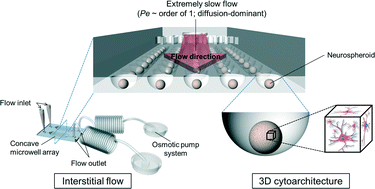Three-dimensional brain-on-a-chip with an interstitial level of flow and its application as an in vitro model of Alzheimer's disease†
Abstract
There has been a growing need for in vitro models of neurodegenerative diseases such as Alzheimer's disease that would enable a better understanding of etiology and faster development of treatment strategies. However, meeting this demand has been held back by the limited ability to mimic the in vivo microenvironment in an in vitro system. Here, we developed a microfluidic chip based on three-dimensional (3D) neurospheroids that more closely mimics the in vivo brain microenvironment by providing a constant flow of fluid that is readily observed in the interstitial space of the brain. Uniform neurospheroids, with cell–cell interactions and contacts in all directions, were formed in concave microwell arrays, and a slow interstitial level of flow was maintained using an osmotic micropump system. Using this platform, we investigated the effect of flow on neurospheroid size, neural network, and neural differentiation. Neurospheroids cultured with flow were larger and formed more robust and complex neural networks than those cultured under static conditions, suggesting an effect of the interstitial level of slow and diffusion-dominant flow on continuous nutrient, oxygen, and cytokine transport and removal of metabolic wastes. We also tested the toxic effects of amyloid-β, which is generally considered to be the major contributor in Alzheimer's disease. Amyloid-β treatment via an osmotic micropump significantly reduced the viability of neurospheroids and caused a significantly more destruction of neural networks, compared to the amyloid-β treatment under static conditions. By adding in vivo-like microenvironments, we propose this 3D culture-based microfluidic chip as an in vitro brain model for neurodegenerative disease and high-throughput drug screening.


 Please wait while we load your content...
Please wait while we load your content...